Silk Flower Arranging:
Must-Know Basic Techniques
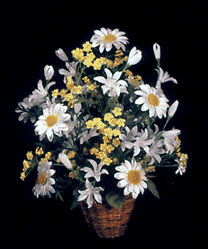
Here you will learn basic silk flower arranging techniques you must know
— how to shape silk flowers, measure and cut stems, and add extensions.
There is also a description of supplies you'll need on hand to make a silk flower arrangement.
During your first silk flower centerpiece projects, keep in mind that you want to get a feel for the process.
Get
used to handling the materials. Practice bending and shaping silk
flower stems and blossoms. Buy a few cheap artificial flower stems — go
ahead, cut them apart, bind an extension to a piece.
The
challenge of making an artificial floral arrangement is in getting
everything to blend together into a pleasing, realistic whole.
Don't worry, your silk flower arranging skills WILL improve quickly as you continually practice and experiment.
It won't be long before you feel comfortable with these important basic techniques.
Silk Flower Arranging:
How to Shape Silk Flowers and Stems
When
you first purchase your silk flowers they may look compacted and
squeezed together. This is due to packing for shipment to the dealer.
Before
using them in an arrangement, spread the branches and blossoms apart so
they don't look crowded. Remove any manufacturers tags and stickers at
this time.
You can now do some preliminary shaping to any parts
that are wired, such as branched stem sections, petals and leaves. Shape
them by applying gentle pressure with your thumb and first two fingers. Try not to make any sharp, angular curves.
Be
sure to shape the main stem sections just a bit, too. Leaving stems
rigidly straight will look unnatural. Strive for an overall lifelike
effect.
As you assemble your silk flower arrangement, additional
shaping may be required. Imagine how real plants and flowers might
look. For example, a bud stalk would curve outward and then up in a
search for sunlight. Petals could be in various stages of bloom. A plump
blossom might droop as if it were a bit heavy for its support. Leaves
would twist in a quest for more growing space. Got it?
If you are not sure how a silk flower stem should be shaped to look natural, search the Internet for pictures of that variety.
Silk Flower Arranging:
Stem Measuring and Cutting
One
thing to keep in mind: as a general rule, the height of a floral
arrangement should be at least 1.5x to 2x the height of the container
for pleasing results.
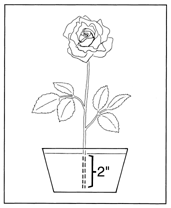
Stem Support
Always allow for an extra length of stem to serve as an anchor in the styrofoam.
Before
cutting any stem, hold it up alongside the container. 'Eyeball' what
length would look good, starting from the point where the stem would
sprout from the styrofoam.
Grasp the stem at that point and make a slight bend in the stem or pencil mark the spot. Cut approximately two inches below that point to leave a good anchor. (Styrofoam sheets are 1 or 2 inches thick. Styrofoam blocks may vary.)
In
all cases, especially for deeper containers, leave anchors as long as
possible. If items are used for other silk flower arranging projects
later on, it will be easier to cut them shorter than to have to add
extensions.
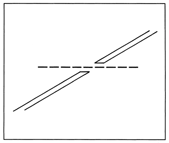
How to Cut Artificial Flower Stems
For easier insertion into the styrofoam, try to cut stems at an angle. This will form a pointed leading edge.
Some
stems are too thick to cut easily. If this is the case, grip the stem
with cutting pliers at the point to be cut. With your other hand, bend
the stem briskly back and forth. Friction will weaken the metal wire
inside the stem and cause it to snap. Then trim the leading edge at an
angle.
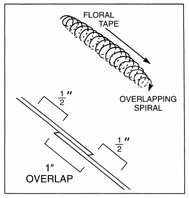
How to Add a Stem Extension
When you first get started in silk
flower arranging, you won't have many stem remnants available as yet —
but make a habit of saving any cuttings that might be of later use.
Cut
stem remnants of three inches and longer can be used as extensions for
short-stemmed items or as sturdy stems for fragile elements, such as
dried flowers or natural Eucalyptus branches.
You can buy stem
wire from a local shop if necessary. Or, for a quick fix, you can use a
paper clip as a stem extension. Just straighten the clip as best you can
and bind to a stem, overlapping at least one to two inches.
Whatever
you choose to use as an extension, use floral tape or paddle wire to
bind them together. (I prefer to use floral tape.)
Overlap the
two pieces one inch or more. Bind them TIGHTLY together, starting .5
inch above the area to be joined. Wrap downward in an overlapping spiral
while applying steady pressure. End the binding .5 inch below the area
being joined.
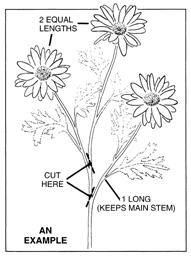
Cutting Silk Flower Stems into Parts
If you want to separate
the blossoms of one stem for placement in different areas, or if a
complete stem would be too much to place in an area, it can be cut
apart.
Clip off a section where it joins the main stem, cutting
at a point where the clipped piece will keep as long a stem as possible.
It can always be cut shorter later.
Add an extension (as explained above) to any stem that may require more height.
Silk Flower Arranging:
Supplies You Will Need
Here is a list of the main floral craft supplies you will need to start on your silk flower arranging adventure:
Styrofoam
A
block of this serves as the foundation for the centerpiece. It comes in
large sheets (3 ft. x 1 ft. x 2 in.) or packaged bricks, in white or
light green colors. Unless a transparent container is used, color makes
no difference since the styrofoam will be covered with moss in most
cases.
Cling Clay, Double-sided Foam Mounting Tape, or Hot Glue Gun
The styrofoam block needs to be secured inside the container. There are several ways to do this.
- Most popular: a gummy, adhesive clay-like substance that comes on a roll (Cling Clay or other names)
- Double-sided foam mounting tape also works very well for securing styrofoam
- Some crafters prefer to use hot glue for strongest, permanent bonding
Moss
Dried
moss can be used to cover the styrofoam for a natural look. It comes in
loose pieces or flat mat shapes, in shades of green and brown. You can
buy it by the bag. Spanish Moss, which looks like curly spaghetti, is
also available in several colors.
Container
Various types of containers, such as baskets, vases, etc., produce different visual effects.
A link at the end of this article will take you to the page on how to prepare a container for a silk flower arrangement.
Silk Flowers and Foliage
Requirements vary. See
silk flower shopping tips.
Floral Tape and/or Paddle Wire
Floral tape is used to
bind loose items, such as single leaves, to a stem. You can also bind an
extension (either stem wire or remnants of trimmed stems) to a stem
that is too short. The floral tape is made of a sturdy paper, which when
slightly stretched, releases a light-tack glue from its pores and
sticks to itself. It works well and looks nice. It comes in green, brown
and other colors.
The paddle wire is very flexible and easy to
use. You can use it to bind a group of items together before attaching
to a stem with floral tape.
You don't need to buy both right
away. Choose the one that you feel comfortable with. (I started with,
and just kept using, the floral tape.)
Cutting Pliers
To trim stems (from any hardware store).
A Knife
To cut the styrofoam (a steak or butter knife is fine).
Click here for a PICTURE GUIDE to the most-used silk flower supplies.
Next: how to prepare a container
(basket, vase, etc.) for silk flower arranging.
|
You're reading a SAMPLE from: |

Check out my 198-page book,
The Silk Flower Centerpiece Handbook:
A Course FOR IMPATIENT PEOPLE...
in a matter of DAYS, not months or years,
you'll know just about everything I've learned over 20 years!
More FREE Silk Flower Arranging How-To!
Sign up now for Silk Flower Smart NEWS to receive email notification about NEW silk floral crafts instructions and articles, floral product reviews and recommendations from Silk-Flower-Smart.com.It's FREE! Don't miss out - sign up now!
Return from Basic Silk Floral Arranging Techniques page
to Silk-Flower-Smart home page
Copyright © 2003-2023 Silk-Flower-Smart.com. All rights reserved.
Unauthorized duplication or publication of any
materials from this Site is expressly prohibited.